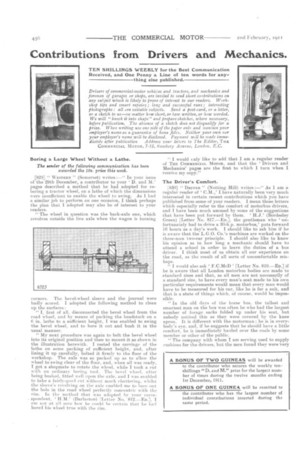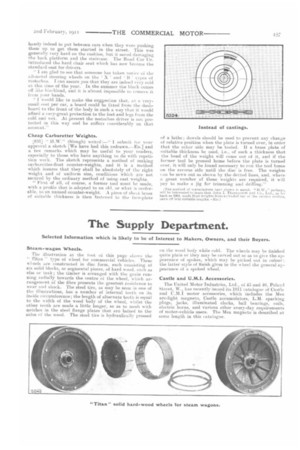Contributions from Drivers and Mechanics.
Page 20

Page 21

If you've noticed an error in this article please click here to report it so we can fix it.
TEN SHILLINGS WEEKLY for the Best Communication Received, and One Penny a Line of ten words for any thing else published.
Drivers of commercial-motor vehictes and tractors, and mechanics and foremen of garages or shops, are invited to send short contributions on any subject which is likely to prove of interest to our readers. Workshop tips and smart repairs ; long and successful runs ; interesting photographs: all are suitable subjects. Send a post-card, or a letter, or a sketch to us—no matter how short, or how written, or how worded. We will "knock it into shape" and prepare sketches, where necessary, before publication. The absence of a sketch does not disqualify for a prize. When writing use one side of the paper only and mention your employer's name as a guarantee of bones fides. Neither your own nor your employer's name will be disclosed. Payment will be made imme diately after publication Address your letters to The Editor, THE COMMERCIAL MOTOR, 7-75, kosebery Avenue, London, E.C.
Boring a Large Wheel Without a Lathe.
The under of the following communication has been awarded the 10s. prize this week.
[829] " 'WESTERN '7 (Somerset) writes :—" In your issue of the 29th December, a contributor to your D. and M. pages described a method that he had adopted for reboring a tractor wheel, on a lathe of which the dimensions were insufficient to enable the wheel to swing. As I had a similar job to perform on one occasion, I think perhaps the plan that I adopted may also be of interest to your readers.
" The wheel in question was the back-axle one, which revolves outside the live axle when the wagon is turning corners. The bevel-wheel sleeve and the journal were badly scored. I adopted the following method to clean Lip tile surfaces: " I, first of all, disconnected the bevel wheel from the road wheel, and by means of pecking the headstock on a 6 in. lathe to a sufficient height, I was enabled to swing the bevel wheel, and to bore it out and bush it in the usual manner.
" My next procedure was again to bolt the bevel wheel into its original position and then to mount it as shown in the illustration herewith. I rested the carriage of the lathe on some packing of sufficient height, and after lining it up carefully, bolted it firmly to the floor of the workshop. The axle was so packed up as to allow the wheel to swing clear of the floor, and, when all was ready. I got a shopmate to rotate the wheel, while I took a cut with an ordinary boring tool. The bevel wheel. after being hushed, fitted well opon the axle, and I was enabled to take a fairly-gond cut without much chnttering, whilst the sleeve's revolving on the axle enabled me to bore out the hole in the road wheel perfectly coneentric with the rim. In the method that was adopted by your COMP spondont, (Dariaston) ['Letter No. 812.—En.], I am not at all sure how lie could be certain that he had bored his wheel true with the rim. " I would only like to add that I am a regular reader of Tem COMMERCIAL MOTOR, and that the Drivers and Mechanics' pages are the first to which I turn when I receive my copy."
The Driver's Comfort.
[830] " DRIVER " (Notting Hill) writes :—" As I am a regular reader of C.M.,' I have naturally been very much interested in certain recent contributions which you have published from some of your readers. I mean those letters which especially refer to the comfort of motorbus drivers, and I have been much amused by some of the suggestions
that have been put forward by them. (Bordesley Crean) [Letter No. 817.—Enl, the gentleman who ' unfortunately had to drive a 30-h.p. motorbus,' puts forward 16 hours as a day's work. I should like to ask him if he is aware that the 1,.0.0. Co.'s machines are worked on the three-men two-car principle. I should also like to know his opinion as to how long a mechanic should have to attend a school in order to learn the duties of a bus driver. I think most of us obtain all our experience on the road, as the result of all sorts of uncomfortable mishaps.
" I would also ask F.C.McD ' [Letter No. 819.—En.] if he is aware that all London motorbus bodies are made to standard sizes and that, as all men are not necessarily of a standard size, to have every man's seat made to his own particular requirements would mean that every man would have to be measured for his ear, like he is for a suit, and that is a state of things which, of course, would be impossible.
"in the old days of the horse bus, the tallest and smartest man on the box was often he who had the largest number of forage sacks folded up under his seat, but nobody noticed this as they were covered by the knee apron. It is different with the motorman ; he is in everybody's eye, and, if he suggests that he should have a little comfort he is immediately hauled over the mails by some member or other of the public.
"The company with whom I am serving used to supply cushions for the drivers, but the men found they werevery handy indeed to put between ears when they were pushing them up to get them started in the street. This was generally very hard on the cushion, but it saved damaging the back platform and the staircase. The Road Car Co. introduced the hard chair seat which has now become the standard seat for drivers.
" I am glad to see that someone has taken notice of the all-metal steering wheels on the ' X ' and'11' types of motorbus. I can assure you that they are indeed very cold at this time of the year. In the summer the black conies off like blacklead, and it is almost impossible to remove it from your hands.
" 1 would like to make the suggestion that, at a verysmall test per car, a board could be fitted from the dashboard to the front of the body in such a way that it would afford a very-great protection to the feet and legs from the cold and wet. At present the motorbus driver is nut protected in this way and he suffers considerably on that account."
Cheap Carburetter Weights.
[831.] " 11.W." (Slough) writes:—'' I submit for your approval a sketch [We have had this redrawn.—En.] and a few remarks which may be useful to your readers, especially to those who have anything to do with repetition work. The sketch represents a method of making carburetter-float counter-weights, and it is a method which insures that they shall be absolutely of the right weight and of uniform size, conditions which are not secured by the ordinary method of using cast weights.
" :First of all, of course, a former tool must be made, with a profile that is adapted to an old. or what is preferable, to an unused counter-weight. A piece of sheet brass of suitable thickness is then fits-teem -le the fare-plate of a lathe; dowels should be used to prevent any change of relative position when the plate is turned over, in order that the other side may be tooled. If a brass plate of suitable thickness be used, i.e., of such a thickness that the head of the weight will conic out of it, and if the former tool be pressed home before the plate is turned over, it will only be found necessary to run the tool home on the reverse side until the disc is free. The weights can be sewn out as shown by the dotted lines, and, where a great number of these weights are required, it will pay to make a. jig for trimming and drilling."
I The method of manufacture 1iershown novel. " H.W.," perhaps,
will he interested to learn that John I. Thornyerott suiti Co., Ltd., as the back as 1901. made float weights from extruded Fiar of the covrec:t section, sawn off into suitable lengths. -En.]






















